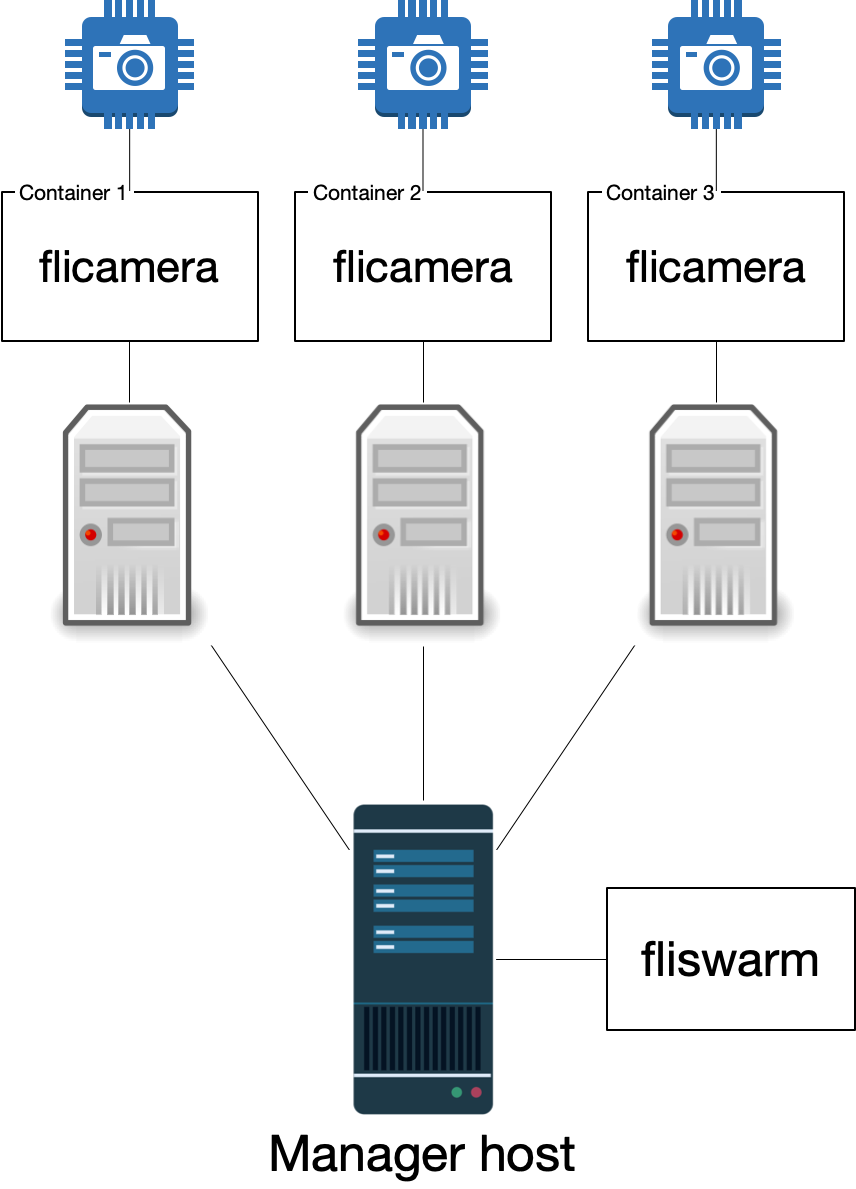fliswarm’s documentation#
This is the documentation for the SDSS Python product fliswarm. The current version is 0.5.1a0.
Installation#
You can install the package by doing
$ pip install sdss-fliswarm
Running fliswarm#
To run the fliswarm actor as a daemon
$ fliswarm [-c config] start
where config is a configuration file for fliswarm. If a configuration file is not provided, the internal configuration will be used. The actor can be stopped with
$ fliswam stop
It’s also possible to run the actor in non-detached mode with
$ fliswarm start --debug
To save the output of the process to a logfile you can do
$ fliswarm start --log <filename>
The actor can also be run by doing
$ module load fliswarm
$ stageManager fliswarm start
How does fliswarm work?#
fliswarm provides an actor-like interface to a set of flicamera instances, each running inside a Docker container in a different node computer. The following diagram shows a typical configuration

In this case we have three different node computers, each one with an attached camera that we want to control using flicamera. A “manager” computer runs fliswarm, which spins a Docker container in each one of the node computers. These containers run an image of flicamera that talks to its local camera. fliswarm connects to each one of the flicamera devices and manages the output, as well as submits commands to one or all the connected instances.
Why not Docker swarm?#
The name fliswarm clearly points to Docker swarm so, why not to use flicamera as a Docker service? The short answer is: that’s the plan. However, at this time Docker services cannot be initiated in privileged mode, which is necessary for the flicamera container to access the node hardware. Once that changes, fliswarm will probably be rewritten to take advantage of the Docker swarm capabilities.
Setting up the manager and nodes#
Both the manager and node computers require a bit of special configuration before they can be used with fliswarm. First, all computers need to be running a recent version of Docker Engine. All the Docker daemon services need to be accessible over TCP on port 2375. In most linux machines this can be achieved by editing /etc/docker/daemon.json and adding the content
{
"hosts": ["tcp://0.0.0.0:2375", "unix:///var/run/docker.sock"]
}
Then create the file /etc/systemd/system/docker.service.d/docker.conf with content
[Service]
ExecStart=
ExecStart=/usr/bin/dockerd
and run sudo systemctl daemon-reload and sudo systemctl restart docker. Follow these instructions for other systems.
The manager computer needs to run a local registry; details for setting one can be found here.
Finally, the node computers must be able to pull images from the local registry. If you haven’t enabled certificates for the local registry, you’ll need to configure the nodes to accept an insecure registry, as described here. In short, edit the /etc/docker/daemon.json file again and add
{
"insecure-registries":["10.25.1.1:5000"],
}
replacing 10.25.1.1 with the IP or hostname to the manager computer that is serving the registry. Then restart the Docker service.
Note
Enabling a local registry is only necessary to ensure that fliswarm can be run offline. If this is not a requirement it is possible to use a remote registry (for example the Docker Hub) by setting the configuration parameter registry to null.
Configuration file#
A valid configuration file, in YAML format, looks like
# CLU-like actor configuration options
actor:
name: fliswarm
host: 127.0.0.1
port: 19996
tron_host: sdss-hub
tron_port: 6093
log_dir: /data/logs/actors/fliswarm
# Address and port to the local registry. Set to null to use Docker Hub
registry: sdss-hub:5000
# Image and tag name
image: sdss5/flicamera:latest
# The prefix of the container name. The final name will be
# flicamera-gfa1, flicamera-gfa2, ...
container_name: flicamera
# Timeout for the ping command to check if the node is alive
ping_timeout: 0.1
# What of the below nodes are enabled
enabled_nodes: [gfa1, gfa2, fvc]
# A dictionary of nodes:
# host: The hostname or IP of the node.
# docker-client: The address to the Docker daemon running on the node.
# category: A string to group similar groups of flicamera instances.
nodes:
gfa1:
host: sdss-gfa1
port: 19995
docker-client: tcp://sdss-gfa1:2375
category: gfa
gfa2:
host: sdss-gfa2
port: 19995
docker-client: tcp://sdss-gfa2:2375
category: gfa
fvc:
host: sdss-fvc
port: 19995
docker-client: tcp://sdss-fvc:2375
category: fvc
# List of volumes that will be mounted in the container. The syntax is the
# same as for the Docker --mount option.
volumes:
data:
driver: local
opts:
type: nfs
o: nfsvers=4,addr=sdss-hub,rw
device: :/data